The Lovers — The Great Wall Walk
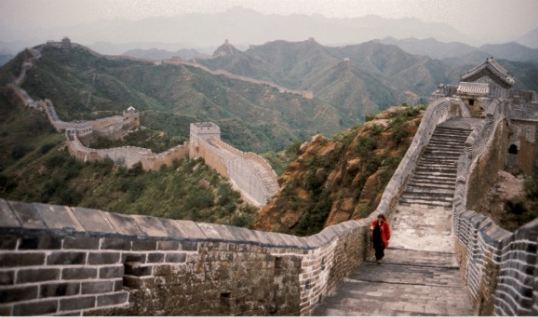
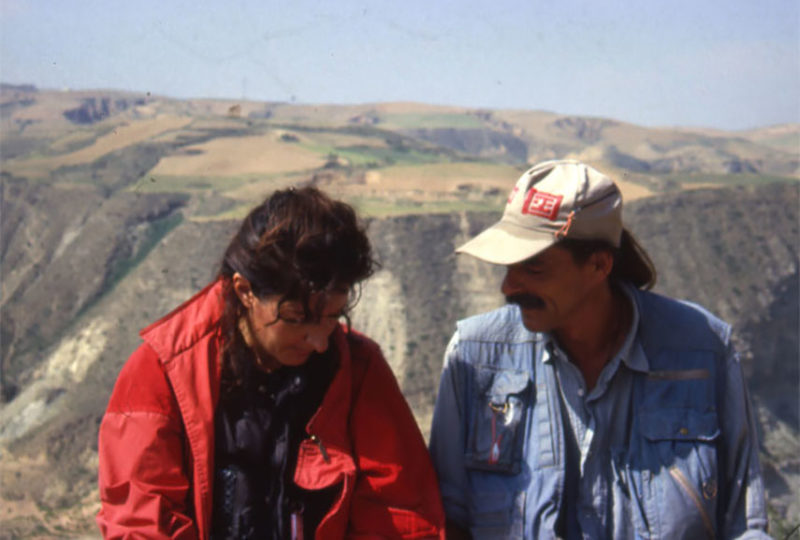
Marina Abramović and Ulay, The Lovers – The Great Wall Walk (1988) China.
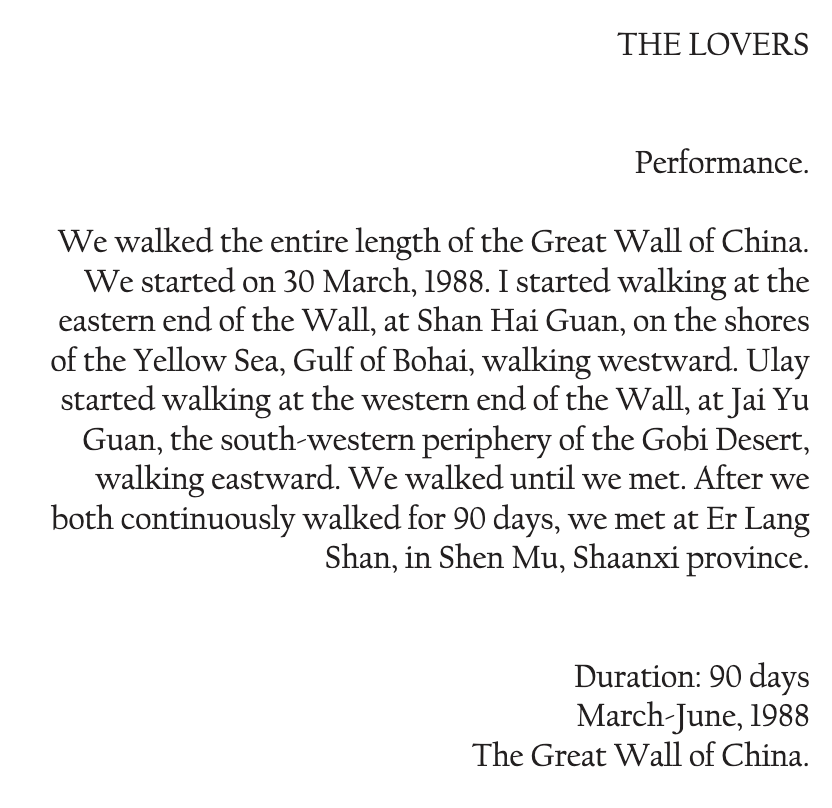
Marina Abramović & Ulay
Abramovic will start walking on the east side of the Wall, while Ulay will start on the west side. It will take three months for the pair to meet in the middle, then they will part and go their separate ways.
It is a great piece of performance art and a grand parting ceremony. In the early stages of a relationship, people often have a confession ceremony; on the way to marriage, they often have a proposal ceremony. But Abramovic and Ulay have created an unusual break-up ceremony.
Pictures From:
First Love
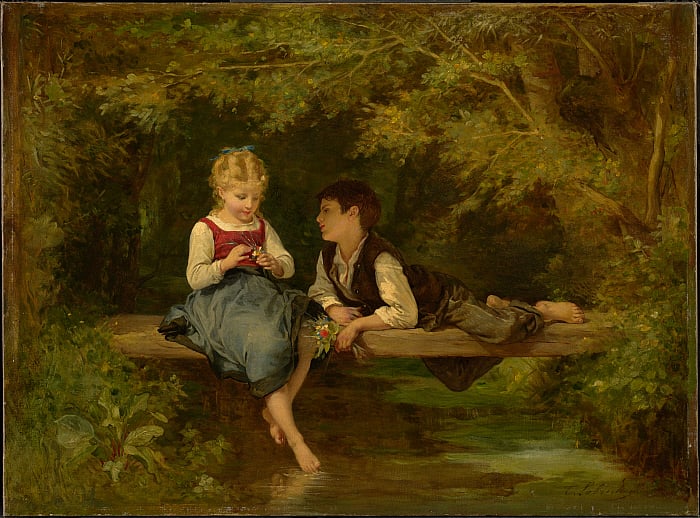
Source From:https://www.clarkart.edu/artpiece/detail/first-love
TIMOLÉON LOBRICHON
FRENCH, 1831–1914
FIRST LOVE
C. 1872
| Medium |
oil on canvas |
| Dimensions |
23 1/2 x 31 3/4 in. (59.7 x 80.6 cm) |
| Object Number |
1955.794 |
| Acquisition |
Acquired by Sterling and Francine Clark before 1955 |
| Status |
Off View |
IMAGE CAPTION
Timoléon Lobrichon, First Love, c. 1872, oil on canvas. Clark Art Institute, 1955.794
PROVENANCE
Possibly sale, George Leavitt, New York, 2–7 Dec. 1872, no. 136; [N. Mitchell, London, sold to Clark, 20 Feb. 1935]; Robert Sterling Clark (1935–55); Sterling and Francine Clark Art Institute, 1955.
Her First Love Letter

- Title
- Her First Love Letter
- Artist/creator
-
- Production date
- 1889
- Medium
- oil on canvas
- Dimensions
- 1100 x 1683 x 60 mm
- Credit line
- Auckland Art Gallery Toi o Tāmaki, gift of Moss Davis, 1930
- Accession no
- 1930/2/1
- Copyright
- No known copyright restrictions
- Department
- International Art
- Display status
- On display
Source From: https://www.aucklandartgallery.com/explore-art-and-ideas/artwork/632/her-first-love-letter?q=%2Fexplore-art-and-ideas%2Fartwork%2F632%2Fher-first-love-letter
我爱你 I Love You
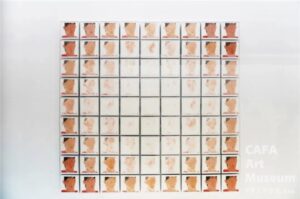
Title
- 我爱你
- Artist/creator
-
XinKun Wu
- Production date
- 2021
- Medium
- Xuan paper
- Dimensions
- 194.4 x 194.4 cm
2021 Works for the Graduation Exhibition of the Central Academy of Fine Arts, China
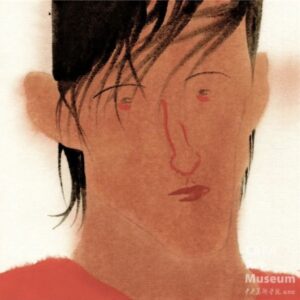
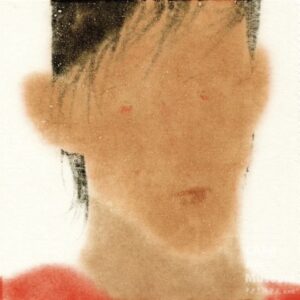

Source From: https://www.cafamuseum.org/exhibit/newsdetail/2954
Tears Of Love
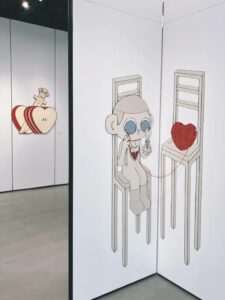

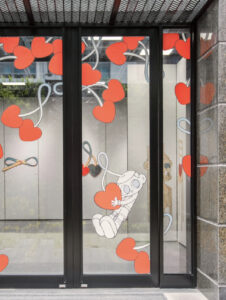

Artist: Slimes
Illustration book ‘Love&Tears’ 118 pages,
58 illustrations Exhibition “Tears Of Love” in Shanghai, China
Source From: RedBook App
Love Letter

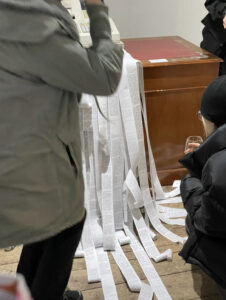
Artist: NoMoon
Installation art Exhibition in London in December 2022
Source From: RedBook App
Insights about Embassy Gallery
Pre-course reading:
- Artists Running: 50 Years of Scottish Cultural Devolution (Brown, Jackson and Mulholland, 2018)
Understanding ARI and ARIs:
ARIs encompass many of the acquisitions that accompany commercial galleries and public museums. It is developed and managed by unpaid artists who are responsible for all aspects of the organisation. ARIs have developed management methods that replace centrally driven top-down organisations with a horizontal distribution of knowledge and practice.
Many existing arts organisations, clubs and voluntary groups in Scotland, such as the RSA, are able to operate without reliance on the state because they only allow existing members to elect their bourgeois peers to attract large donations. ARIs, however, are not sponsored by capital and are entirely voluntary for artists.
After 1967, the visual arts in Scotland were shaped by the mutual development of the ARI and the SAC.
Scotland has a long tradition of ARI. Artist-run initiatives have played a vital role in addressing the institutional and economic barriers to creative and professional development.
ARIs are divided into – ARIs that present work to an audience and – ARIs that provide artists with the tools of their trade.
ARIs have a rolling committee of six or seven members who are voluntarily responsible for all aspects of the gallery’s work. This also ensures that the organisation is updated every few years and that there are new influences as people change. But the transition of committees can also lead to relevant knowledge and documentation being easily lost.
ARI doxa Important for:
1. mobility to adapt to new situations and flourish.
2. cultural amnesia can be seen as nourishing experimental art.
3. a strong ethic that binds local communities and provides forms of self-empowerment. Social relationships are built and maintained through reciprocal participation and self-subsidisation.
4. connects diverse communities through local and transnational networks. Promising to provide a single authority that dismantles world hierarchies.
- Governance of the Possible (Baert, Schick and Trotman, 2020)
Paradigm shift
Western society, and its cultural sector, is based on the principle of the exploitation and extraction of others and the environment. The dominant forces in the arts operate on the front lines of neoliberalism, embodying its ideology, and the work of the RESHAPE project centres on understanding how these artistic forces function on the ground in different regions and contexts. On the one hand it is about reinventing parts of culture by listening to, shifting and focusing the voices of those deeply affected by exploitation, and on the other hand it is about allowing new things to happen and grow through the complete abolition of the cultural sector. To begin this work/prototype/change, harmful relationships, practices and structures that hinder the ability to re-imagine need to be broken down by abandoning European institutions and funding agencies and re-establishing the ideal of ‘artistic excellence’ as the basis.
Helga Baert, Martin Schick and Sam Trotman call for a new paradigm of art in terms of shared responsibility and collective survival of culture, freedom and justice. In doing so, they co-create new narratives, shared goals, and forms of cooperation.
Governance of the possible (GOTP)
Through the RESHAPE project, the authors developed a collective space to develop a more equitable model of artistic governance and tested it within our own roles and organisations.GOTP refers to the architecture of the possible, where urgent needs and informality determine the next steps in development. By practising GOTP, artists can detach themselves from their own work and individualised cultural organisations to refocus and reorganise in order to create a culture-centred responsibility for collective survival.Within GOTP, artists are able to create a culture-centred responsibility through Being many, Sharing values, Root and connect, Resourcing, Evaluation, Fair(y)ness, De-project, How to end and How to start.
A collection of (GOTP) practices
Artists write by listening, sensing and letting it happen, without concern for authorship. This way of writing allows for the development of practices and ideas that explore collective differences, transcend the understanding of individual perspectives, group dynamics, and transcend human-centred logic. Again a range of positive effects and outcomes are achieved.
A practical tool used by GOTP to think and discuss widely, to ask difficult or questioning questions, it can also help collaborators to move beyond their inherent logic and build evolved collective forms.
This is a new tool for payment and remuneration, a combination of self/group-assessment, flexible salary, and the Common Wallet.
Class Notes

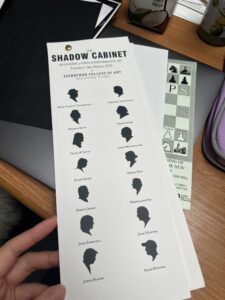
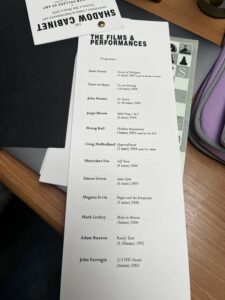
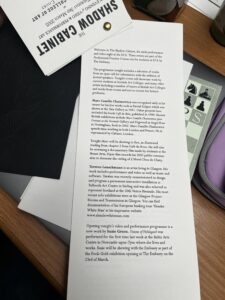
Through the introduction by Embassy staff, I learned that Embassy is an Artist Leadership Organisation that aims to support artists by promoting exhibitions, events, festivals and more. Also as mentioned in the pre-course reading material, they have a management committee with a two-year turnover period, which also facilitates them to innovate and develop with a progressive process. Also, there is no hierarchy in their work, there are no more senior people, which shows that everyone is equal in the whole team. I think this is also the most crucial experience of their solidarity and cooperation.
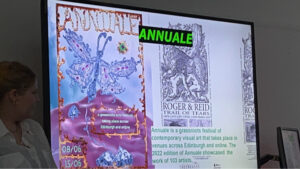
One of the more impressive programmes that Embassy introduced to me was the annual arts festival. People get to perform at different venues and then the staff go and promote it. At last year’s festival, Embassy had a website to showcase the different events and exhibitions that were happening. They also have an online exhibition and there are a lot of artists involved in different ways and with different exhibitions.
Also, the staff at Embassy have mentioned that when we plan projects and events, we need to think about the structure of the space and how it works, such as how a space is allowed to operate. Another thing that struck me was that they had thought about membership and considered the structure of the membership and what could be offered to them. For the events we are doing now, Embassy staff have suggestions for ad hoc projects like this and we need to think about what is the outcome of the project? Who are we talking to, what are the intentions and can they be incorporated into existing programmes, or can they be involved?
I found that the Embassy team operate under unconventional rules, they identify tasks each week, need to work on a hit and then meet to decide, this is good for rotating and keeping things moving, it also ensures they can work without a hierarchy. It’s well worth learning from our profession as a team.
For my own personal project, Embassy had a case study to explain, one that was like a Valentine’s Day programme, with something about love. The questions they thought about were also worthy of my consideration, such as the one they mentioned “What specific elements of love are we all interested in? Which artists are interested in this and work with it. And they mentioned that it’s not a good option to just take other people’s work and insert it into our own curatorial projects. I need to think about a really collaborative way to work.
























Recent comments